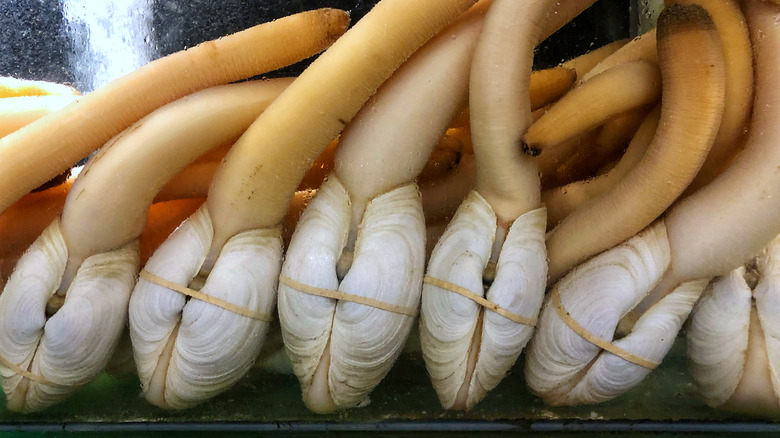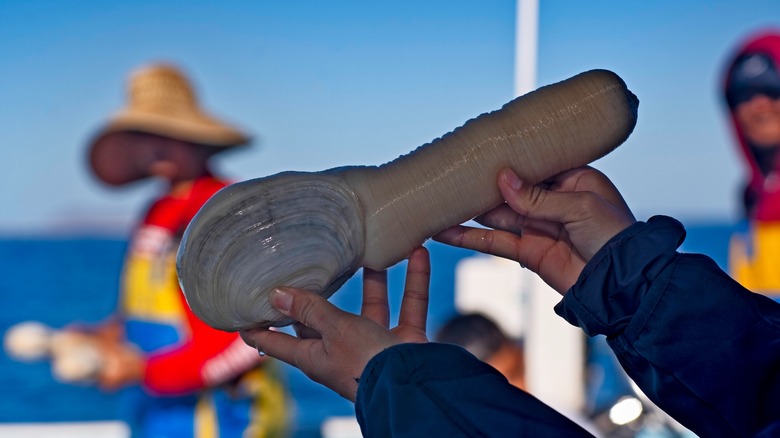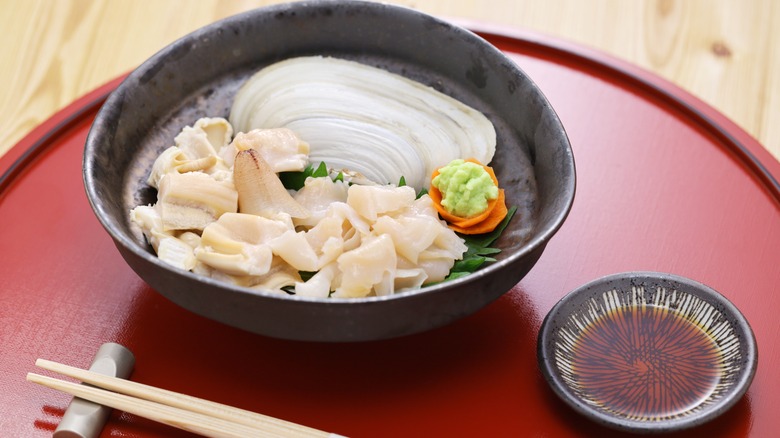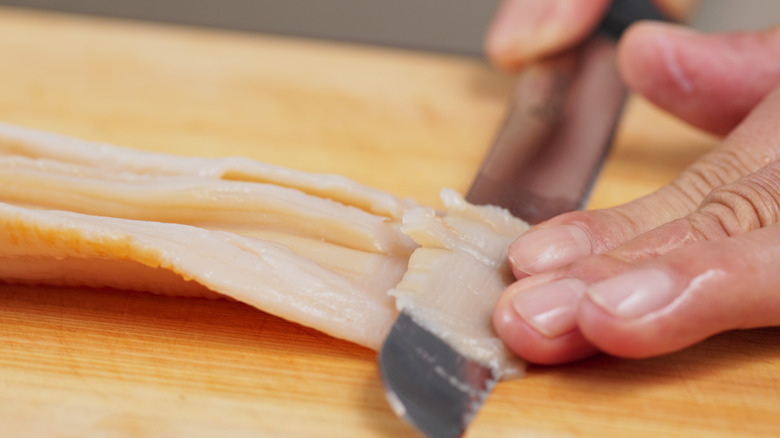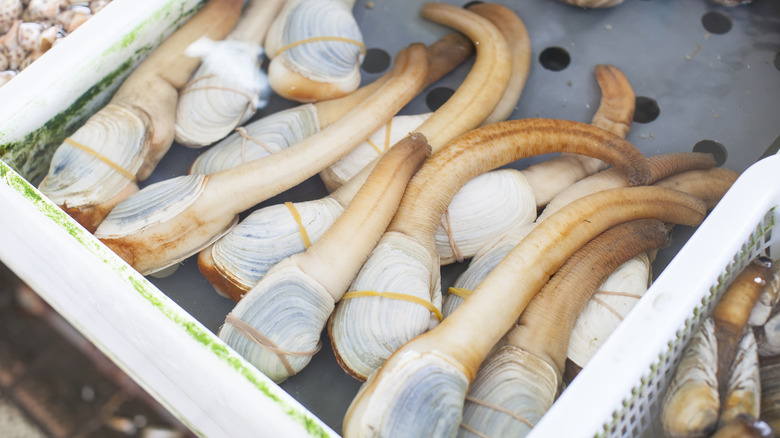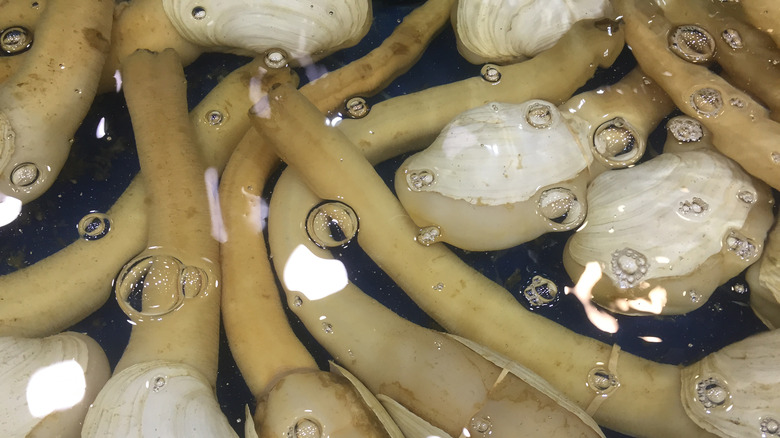What Is A Geoduck And How Is It Eaten?
Nestled beneath the sand on the subtidal beaches of the Pacific Northwest, a unique mollusk called a geoduck (Panopea generosa) makes its home. Pronounced "gooey duck," this bivalve gets its name from the Nisqually Tribe, whose traditional and current homelands are in present-day Washington. In their language, Lushootseed, geoducks are referred to as "gʷídəq," meaning "dig deep." And that is exactly what you will have to do if you want to harvest one of these mollusks for yourself.
These large creatures can weigh up to several pounds, and their necks can grow to a few feet long. Moreover, they can live for up to 150 years. Geoducks are a beloved regional food item in the Pacific Northwest and are regarded as an imported delicacy in countries like Japan and China. While its unique elephant trunk-like shape may put you off at first, don't be fooled — these bivalves are truly something special and one you need to stop overlooking.
What is a geoduck?
The geoduck is typically found one-three feet below ground in subtidal waters in parts of Washington, Alaska, and British Columbia and its native range extends as far south as Baja California. Part of the family Hiatellidae, the thing that visually distinguishes geoducks from other mollusks is its neck. The geoduck has a shell with meat on the inside, and a large neck also called a siphon. This siphon sucks in seawater below the sand, separating nutrients and algae and spitting back what it doesn't need. The geoduck also has a little foot which it uses to anchor itself firmly in place. Geoducks are burrowers, but they don't move laterally throughout their lives — uninterrupted, they stay in the same spot.
Regionally, geoducks have tribal, commercial, and recreational significance. Buying a single geoduck is quite expensive — you will likely pay between $15 and $30 dollars for every pound. Geoducks are a significant part of the bivalve market in the Pacific Northwest.
What do geoducks taste like?
Compared to other bivalves, the geoduck flavor is slightly sweet. Like clams and oysters, a fresh geoduck should taste slightly of salt water, but not be fishy. The brininess is due to years spent below the sand. This amicable and clear flavor means that geoducks don't need much enhancement to taste great, but they are also a pleasant addition to more complex recipes like chowders or a Chinese hot pot. Your cooking method can also deepen some of the natural flavors of the geoduck, as long as you do not overcook it.
The texture of a geoduck will depend on how it is consumed. Cooked geoduck is often slightly chewier. Raw geoduck, on the other hand, has a crisp bite to it that you don't find very much with other bivalves. This crunch likely comes from the thickness of the neck. Despite this, fresh geoduck meat is very tender.
How to cook with geoducks
Cooking with geoducks may seem intimidating to a novice, but it is actually simpler than you would think. Many people either eat geoduck raw or very lightly sauteed. Because of its delicacy status in places like China and Japan, you will find recipes in these cuisines that call for geoduck. Remember, one geoduck can be enough to feed several people.
The neck of the geoduck has a tough skin encapsulating it, but this is very easily solvable with a quick blanch. Bring a pot of water to a boil and dunk the geoduck in its entirety into the water. This can be difficult since the geoduck neck can be several feet long, so make sure you pick a big enough pot. After just 10-15 seconds, remove the geoduck carefully and dunk it in an ice bath. This halts the cooking. After blanching, the skin peels right off and the shell opens, allowing you to access the meat within. For more help, check out this collection of tips for cooking with shellfish.
Where to buy geoducks
Access to geoducks is largely dependent on region. To purchase, go to a specific seafood market or fishmonger, or someone who harvests geoducks as a specialty. Some operations participate in geoduck aquaculture, the practice of cultivating geoducks for consumption. However, this can be controversial because of environmental impacts.
If you aren't looking to prepare them yourself, there are several notable restaurants in places like Seattle that feature geoduck on their menu. In countries like Japan and China, geoducks are a popular delicacy. But if you are in the Pacific Northwest and want to harvest geoducks yourself, you can! You'll need to obtain proper licensing and some basic equipment (namely, a shovel), but recreational harvest in Washington is quite popular. But be aware — you will get dirty. If you are not in any of these areas and can't find a place to buy geoducks locally, it is possible to get one shipped to you.
Nutritional information about geoducks
Geoducks, and shellfish in general, provide a healthy source of protein. Per Washington Sea Grant, as little as 20-28% of the calories in a geoduck comes from fat. And even with that low percentage, the types of fats in shellfish are generally positive additions to your diet. Geoducks are a high-protein, low-fat food that is a good addition to your meal plan.
The most important thing to consider when obtaining geoducks is whether the animal comes from an area with safe water quality levels. Geoducks can be a cause of Paralytic Shellfish Poisoning (PSP) during toxic algae blooms. Some algae produce biotoxins, and since geoducks eat algae, the biotoxins can accumulate in the geoduck. Geoducks won't show signs of having accumulated these toxins, but they can cause serious illness and even death in humans.
Fortunately, there are resources available to help make sure you can avoid this health hazard. If you are harvesting your own geoducks, check local advisories and beach closures on the day you plan to go harvest. If you take precautions to harvest safe geoducks, you'll find them to be a very nutritious addition to your diet! They might even make you ... happy as a clam.
